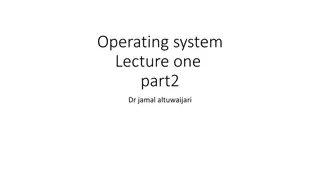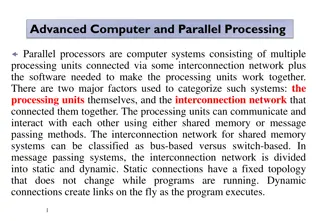Overview of Task Computing in Parallel and Distributed Systems
Task computing in parallel and distributed systems involves organizing applications into a collection of tasks that can be executed in a remote environment. Tasks are individual units of code that produce output files and may require input files for execution. Middleware operations coordinate task execution, manage dependencies, and monitor task status. Computing categories include High-Performance Computing (HPC) and High-Throughput Computing (HTC) for different computational needs. Frameworks like Condor and Globus Toolkit support task computing, and task-based application models include embarrassingly parallel applications with independent tasks.
Uploaded on Sep 25, 2024 | 0 Views
Download Presentation

Please find below an Image/Link to download the presentation.
The content on the website is provided AS IS for your information and personal use only. It may not be sold, licensed, or shared on other websites without obtaining consent from the author. Download presentation by click this link. If you encounter any issues during the download, it is possible that the publisher has removed the file from their server.
E N D
Presentation Transcript
High-Throughput Computing Task Programming/Computing A task generally represents a program, which might require input files and produce output files as a result of its execution. Applications are then constituted of a collection of tasks. Organizing an application in terms of tasks for developing parallel and distributed computing applications. A task is represented as a distinct unit of code, or a program, that can be separated and executed in a remote runtime environment.
Middleware operations Coordinating execution on a set of remote nodes Moving programs to remote nodes and managing their dependencies Creating an environment for execution of tasks on the remote nodes Monitoring each task s informing the user about its status Access to the output produced by the task and scheduling tasks for execution and
Computing categories High-performance computing(HPC) is the use of distributed computing problems that need large computing power. The general profile of HPC applications is constituted by a large collection of compute- intensive tasks that need to be processed in a short period of time. The metrics to evaluate HPC systems are floating- point operations per second(FLOPS), now tera- FLOPS or even peta-FLOPS facilities for solving
Computing categories High-throughput computing(HTC) is the use of distributed computing applications requiring large computing power over a long period of time. Many-task computing (MTC) MTC is similar to HTC, but it concentrates on the use of many computing resources over a short period of time to accomplish many computational tasks. facilities for
Frameworks for task computing Condor is probably the most widely used and long- lived middleware for workstations, and a collection of clusters. Globus Toolkit is a collection of technologies that enable grid computing. Nimrod/G is a tool for automated modeling and execution of parameter (parameter studies) over global computational grids. Berkeley Open Infrastructure Computing(BOINC) is framework for volunteer and grid computing. managing clusters, idle sweep applications for Network
Task-based application models : Embarrassingly parallel applications embarrassingly parallel applications constitute a collection of tasks that are independent from each other and that can be executed in any order. Frameworks and embarrassingly parallel applications are the Globus Toolkit, BOINC, and Aneka. E.g: image and video rendering task, scientific applications tools supporting
Parameter sweep applications Parameter sweep applications are a specific class of embarrassingly parallel applications for which the tasks are identical in their nature and differ only by the specific parameters used to execute them. Parameter sweep applications are identified by a template task and a set of parameters. the template task is often expressed as single file that composes together the commands provided The commonly avail- able commands are: Execute. Executes a program on the remote node Copy. Copies a file to/from the remote node. Substitute. Substitutes the parameter values with their placeholders inside a file. Delete. Deletesafile. For example, Nimrod/G is natively designed to support the execution of parameter sweep applications, Aneka provides client-based tools for visually composing a template task, defining parameters. E.g: evolutionary optimization algorithms, weather-forecasting models, computational fluid dynamics applications
Parameter sweep applications: Genetic algorithms
Aneka parameter sweep file Files required to execute task
Message Passing Interface (MPI) Applications Message Passing Interface(MPI) is a specification for developing parallel programs that communicate by exchanging messages. MPI provides developers with a set of routines that: Manage the distributed environment where MPI programs are executed Provide facilities for point-to-point communication Provide facilities for group communication Provide support for data structure definition and memory allocation Provide basic support for synchronization with blocking calls
Workflow applications with task dependencies A workflow is the automation of a business process, in whole or part, during which documents, information or tasks are passed from one participant (a resource; human or machine) to another for action, according to a set of procedural rules. structured execution of tasks that have dependencies on each other. A scientific work flow is generally expressed by a directed a cyclic graph(DAG), which defines the dependencies among tasks or operations. The nodes on the DAG represent the tasks to be executed in a workflow application; the arcs connecting the nodes identify the dependencies among tasks and the data paths that connect the tasks.
Workflow technologies Business Process Execution Language (BPEL)























